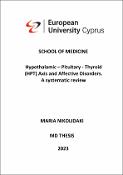Options
Hypothalamic – Pituitary - Thyroid (HPT) Axis and Affective Disorders. A systematic review
Author(s)
Nikolidaki, Maria
Advisor(s)
Johnson, Elizabeth O.
Abstract
Affective disorders have consistently been linked to thyroid hormone imbalances. Many symptoms of hypothyroidism overlap with those of major depressive disorder.
Because of the tight interaction between the thyroid and adrenal systems, it is not clear whether psychiatric manifestations are attributed to the direct effects of thyroid hormone imbalances, or to resultant changes in adrenal axis function. This study aimed to review and summarize the available evidence on thyroid and adrenal axis involvement in the development of primary affective disorders. The PubMed, Scopus, and ScienceDirect databases were systematically searched and after applying the defined eligibility criteria, twenty-six studies were deemed eligible for this review. The risk of bias was assessed with the use of a modified quality rating system and each study was assigned a specific score. Three types of study designs were included: cross-sectional studies, cohort studies, and case-controlled studies. One of the main findings was an association between depression and subclinical hypothyroidism, specifically an elevation in thyrotropin-releasing hormone (TSH). Evidence of hypothalamic-pituitary-adrenal (HPA) axis hyperactivation, mainly in the form of increased cortisol levels, was also present in depressed patients. Other common findings included a blunted thyrotropin-releasing hormone (TSH) response to thyrotropin-releasing hormone (TRH) stimulation, elevated adrenocorticotropic hormone (ACTH) levels, and dexamethasone suppression test (DST) nonsuppression.
The degree of thyroid dysfunction correlated with the severity of psychiatric symptoms, especially in cases of suicidal patients. These findings are in line with clinical recommendations for additional screening for thyroid dysfunction in
patients with major depressive disorder and emphasize the need for future research to better comprehend the involvement of the thyroid and adrenal systems in the pathogenesis of depression.
Because of the tight interaction between the thyroid and adrenal systems, it is not clear whether psychiatric manifestations are attributed to the direct effects of thyroid hormone imbalances, or to resultant changes in adrenal axis function. This study aimed to review and summarize the available evidence on thyroid and adrenal axis involvement in the development of primary affective disorders. The PubMed, Scopus, and ScienceDirect databases were systematically searched and after applying the defined eligibility criteria, twenty-six studies were deemed eligible for this review. The risk of bias was assessed with the use of a modified quality rating system and each study was assigned a specific score. Three types of study designs were included: cross-sectional studies, cohort studies, and case-controlled studies. One of the main findings was an association between depression and subclinical hypothyroidism, specifically an elevation in thyrotropin-releasing hormone (TSH). Evidence of hypothalamic-pituitary-adrenal (HPA) axis hyperactivation, mainly in the form of increased cortisol levels, was also present in depressed patients. Other common findings included a blunted thyrotropin-releasing hormone (TSH) response to thyrotropin-releasing hormone (TRH) stimulation, elevated adrenocorticotropic hormone (ACTH) levels, and dexamethasone suppression test (DST) nonsuppression.
The degree of thyroid dysfunction correlated with the severity of psychiatric symptoms, especially in cases of suicidal patients. These findings are in line with clinical recommendations for additional screening for thyroid dysfunction in
patients with major depressive disorder and emphasize the need for future research to better comprehend the involvement of the thyroid and adrenal systems in the pathogenesis of depression.
Date Issued
2023-07-04
Department
School
Publisher
School of Medicine : MD Doctor of Medicine
File(s)
Loading...
Name
MD Thesis - Maria Nikolidaki.pdf
Description
Master Thesis
Size
1.37 MB
Format
Checksum